Most people infected with pinworms are asymptomatic. However, children with symptomatic disease who present for medical care are most likely to complain of perianal itching.
History
Pinworm infection is most common in school-aged children and their carers.[1]Kimberlin DW, Barnett ED, Lynfield R, et al, eds. Red Book: 2021-2024 report of the committee on infectious diseases. 32 nd ed. Elk Grove Village, IL: American Academy of Pediatrics; 2021 [internet publication].
https://publications.aap.org/redbook/book/347/chapter-abstract/5755005/Pinworm-Infection-Enterobius-vermicularis
[13]Centers for Disease Control and Prevention. Parasites - enterobiasis (also known as pinworm infection): epidemiology and risk factors. Jan 2013 [internet publication].
https://www.cdc.gov/parasites/pinworm/epi.html
Intense perianal itching is the most common complaint. This is worse at night and may be associated with restlessness or insomnia.
Pinworms are highly transmissible, so known infection in a household, classroom, or institutional contact of an individual with anal pruritus are highly suggestive of disease. Pinworms rarely cause extraintestinal symptoms. The most common location for ectopic disease is the female genitourinary tract, where vulvar pruritus may occur.[1]Kimberlin DW, Barnett ED, Lynfield R, et al, eds. Red Book: 2021-2024 report of the committee on infectious diseases. 32 nd ed. Elk Grove Village, IL: American Academy of Pediatrics; 2021 [internet publication].
https://publications.aap.org/redbook/book/347/chapter-abstract/5755005/Pinworm-Infection-Enterobius-vermicularis
History of fever, weight loss, or other systemic signs of infection suggest an alternative diagnosis.
Examination
This is typically normal except for the perianal area, which may be excoriated. Vulvar irritation may also be present. Occasionally, worms may be visualised migrating out of the anus if the child is examined during the night, either by the parent at home or the clinician in the accident and emergency department setting.
Investigations
The adhesive tape test is used to diagnose pinworm infection.[12]Centers for Disease Control and Prevention. Parasites - enterobiasis (also known as pinworm infection). Jun 2023 [internet publication].
https://www.cdc.gov/parasites/pinworm/index.html
This test should be performed on at least 3 consecutive days (immediately after awakening and before washing) to maximise sensitivity.[1]Kimberlin DW, Barnett ED, Lynfield R, et al, eds. Red Book: 2021-2024 report of the committee on infectious diseases. 32 nd ed. Elk Grove Village, IL: American Academy of Pediatrics; 2021 [internet publication].
https://publications.aap.org/redbook/book/347/chapter-abstract/5755005/Pinworm-Infection-Enterobius-vermicularis
[16]Centers for Disease Control and Prevention. CDC Yellow Book 2024: health information for international travel. Section 5: travel-associated infections and diseases - enterobiasis / pinworm. May 2023 [internet publication].
https://wwwnc.cdc.gov/travel/yellowbook/2024/infections-diseases/enterobiasis-pinworm
[21]Centers for Disease Control and Prevention. Parasites - enterobiasis (also known as pinworm infection): diagnosis. Jan 2013 [internet publication].
https://www.cdc.gov/parasites/pinworm/diagnosis.html
[Figure caption and citation for the preceding image starts]: Enterobius eggs on adhesive tapeImage provided by the CDC Division of Parasitic Diseases and Malaria; used with permission [Citation ends].
As eggs are not commonly shed in the stool, examination of stool for ova and parasites is not indicated. As there is no extraintestinal phase of the pinworm life cycle, eosinophilia is absent. Similarly, there is no antibody response and no serological testing available.[1]Kimberlin DW, Barnett ED, Lynfield R, et al, eds. Red Book: 2021-2024 report of the committee on infectious diseases. 32 nd ed. Elk Grove Village, IL: American Academy of Pediatrics; 2021 [internet publication].
https://publications.aap.org/redbook/book/347/chapter-abstract/5755005/Pinworm-Infection-Enterobius-vermicularis
[16]Centers for Disease Control and Prevention. CDC Yellow Book 2024: health information for international travel. Section 5: travel-associated infections and diseases - enterobiasis / pinworm. May 2023 [internet publication].
https://wwwnc.cdc.gov/travel/yellowbook/2024/infections-diseases/enterobiasis-pinworm
[21]Centers for Disease Control and Prevention. Parasites - enterobiasis (also known as pinworm infection): diagnosis. Jan 2013 [internet publication].
https://www.cdc.gov/parasites/pinworm/diagnosis.html
